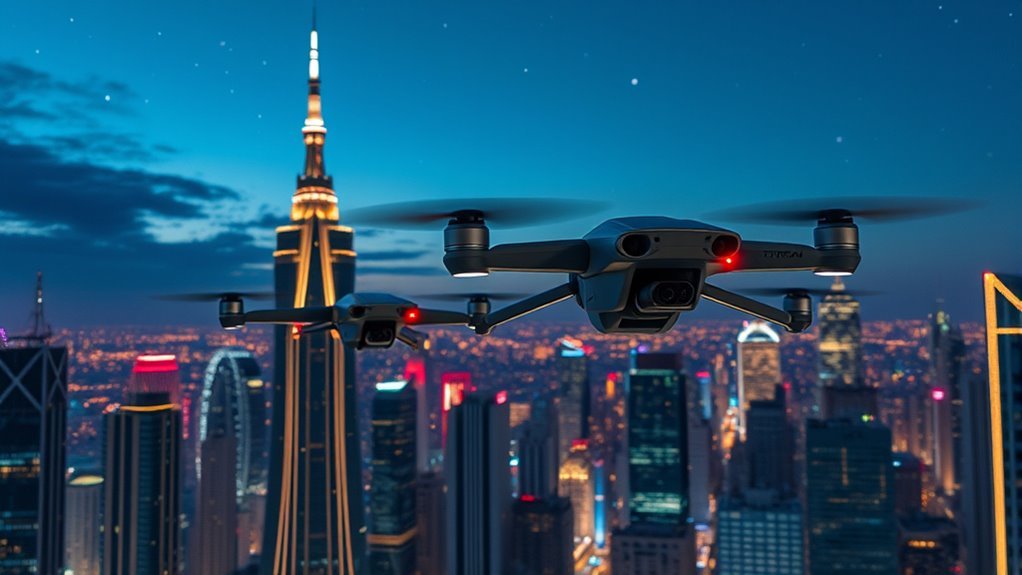By 2025, you’ll see consumer drone brands evolving with advanced AI for autonomous navigation and batteries lasting up to 45 minutes, making flights safer and more efficient. These innovations will address regulatory challenges and high costs, fostering wider adoption for everyday uses like aerial photography and agricultural monitoring. As you explore the sections below, you’ll uncover deeper insights into these transformative trends.
Key Points
- By 2025, consumer drone brands will prioritize AI-driven autonomous navigation for safer and more efficient flights.
- Extended battery life up to 45 minutes will enable brands to offer longer, uninterrupted drone experiences.
- Brands will focus on sleek, customizable designs using lightweight materials to enhance user appeal and exploration.
- Regulatory compliance features will become standard, helping brands navigate airspace restrictions and boost market trust.
- Drone brands will integrate seamlessly with smart devices for everyday applications like delivery and agricultural monitoring.
Key Trends in Consumer Drone Development
As the drone industry advances toward 2025, you’ll see key trends like enhanced AI for autonomous navigation and longer-lasting batteries reshaping consumer drone development, fostering safer, more efficient designs that address regulatory demands and user needs.
In this evolution, design aesthetics play a pivotal role, blending sleek, ergonomic forms with modular components that let you customize drones for personal adventures. These innovations prioritize lightweight materials and intuitive interfaces, empowering you to explore freely while meeting stringent regulatory frameworks. As governments tighten rules on airspace and safety, you’ll benefit from drones that adapt seamlessly, incorporating compliance features without stifling creativity. This forward-thinking approach guarantees balanced growth, where aesthetic appeal drives market appeal and regulatory adherence enhances reliability. Ultimately, these trends liberate you to innovate and operate with greater autonomy, turning regulatory challenges into opportunities for expansive, user-centric designs that define 2025’s landscape.
Innovations in AI and Navigation Systems
While AI innovations propel drone navigation forward, you’ll experience systems that integrate machine learning for seamless autonomous flight, enhancing safety and efficiency in 2025. AI algorithms will empower you to explore vast skies with unprecedented precision, as they process real-time data for obstacle avoidance and dynamic path adjustments. Autonomous navigation becomes your gateway to freedom, allowing drones to adapt intelligently to changing environments without constant human intervention. You’ll see advanced AI algorithms analyzing terrain and weather patterns, minimizing risks and maximizing flight capabilities. This evolution not only streamlines operations but also opens new avenues for creative applications, like aerial photography in remote areas. As consumer brands prioritize these technologies, you’ll gain the liberty to push boundaries, turning drones into reliable extensions of your vision. Ultimately, these advancements guarantee that by 2025, your drone flights are safer, smarter, and more liberating than ever.
Battery Life and Performance Enhancements
Because battery technology is advancing rapidly, you’ll benefit from drones that offer extended flight times and superior performance by 2025. These improvements will empower you to explore further with longer flights, enhanced energy efficiency, and optimized power systems, freeing you for uninterrupted adventures in photography or surveillance.
By 2025, advancing battery tech will deliver drones with extended flights and superior performance for seamless exploration.
To maximize your drone experiences, consider these key enhancements:
- Longer flights: Expect batteries lasting up to 45 minutes, allowing you to cover vast distances without frequent recharges, ideal for remote exploration.
- Energy efficiency: New materials like solid-state batteries will reduce weight while boosting capacity, enabling smoother, longer operations with less environmental impact.
- Rapid charging: Quick recharge times under 30 minutes will minimize downtime, giving you the freedom to seize spontaneous opportunities.
- Integrated performance boosts: Smarter power management systems will optimize thrust and stability, ensuring reliable flights in diverse conditions.
Challenges in Market Adoption
Despite the promising battery enhancements, you’ll face several hurdles in adopting consumer drones by 2025, such as regulatory restrictions and high costs that could slow widespread use. Regulatory hurdles, including evolving airspace rules and privacy laws, will demand compliance to preserve your freedom to fly, potentially limiting access in urban areas. You’ll also need robust user education to navigate these complexities safely; without it, mishandling could lead to accidents or legal issues, stifling innovation. As regulations tighten globally, brands must prioritize affordable training programs and intuitive interfaces to empower you. Looking ahead, overcoming these barriers will require advocacy for balanced policies that support personal exploration while ensuring public safety. By 2025, proactive education and cost reductions could turn these challenges into opportunities for greater drone accessibility, fostering a liberated skies experience.
Everyday Applications and Integration Strategies
As consumer drones evolve by 2025, you’ll find everyday applications ranging from aerial photography and home delivery to recreational exploration, all while integration strategies focus on seamless connectivity with smart devices. This forward-thinking approach empowers you to integrate drones into daily life, offering tools for efficiency and autonomy in a connected world.
To maximize your freedom with these technologies, consider these key strategies:
To maximize your freedom with drone technologies, explore these key strategies.
- Master aerial photography and recreational flying: Capture breathtaking visuals and explore open skies, giving you the liberty to document personal journeys without boundaries.
- Streamline home delivery and urban mapping: Enhance logistics for faster deliveries and detailed city navigation, allowing you to optimize routes and reclaim time for what matters.
- Leverage agricultural monitoring: Use drones for precise crop analysis, enabling sustainable farming decisions that free you from traditional constraints.
- Prepare for disaster response: Deploy drones for rapid assessments in crises, empowering you to respond effectively and safeguard communities with real-time data.

